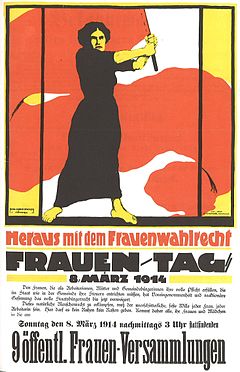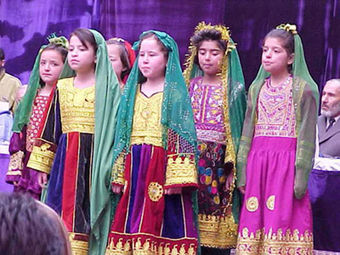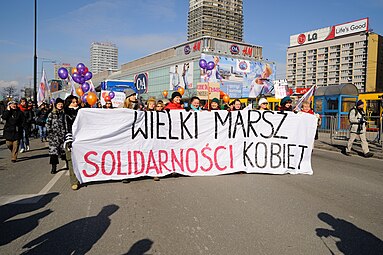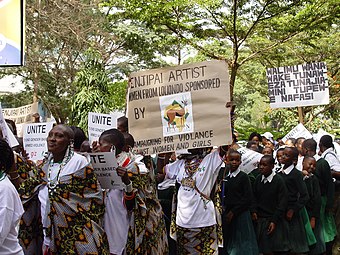International Women's Day (IWD), originally called International Working Women's Day, is celebrated on March 8 every year. In different regions the focus of the celebrations ranges from general celebration of respect, appreciation, and love towards women to a celebration for women's economic, political, and social achievements. Started as aSocialist political event, the holiday blended the culture of many countries, primarily in Europe, especially those in the Soviet Bloc. In some regions, the day lost its political flavor, and became simply an occasion for people to express their love for women in a way somewhat similar to a mixture ofMother's Day and Valentine's Day. In other regions, however, the political and human rights theme designated by the United Nations runs strong, and political and social awareness of the struggles of women worldwide are brought out and examined in a hopeful manner. Some people celebrate the day by wearing purple ribbons.
History
The earliest Women’s Day observance was held on February 28, 1909, in New York; it was organized by the Socialist Party of America in remembrance of the 1908 strike of the International Ladies' Garment Workers' Union. There was no specific strike happening on March 8, despite later claims.
In August 1910, an International Women's Conference was organized to precede the general meeting of the Socialist Second International in Copenhagen, Denmark. Inspired in part by the American socialists, German Socialist Luise Zietz proposed the establishment of an annual 'International Woman's Day' (singular) and was seconded by fellow socialist and later communist leaderClara Zetkin, although no date was specified at that conference. Delegates (100 women from 17 countries) agreed with the idea as a strategy to promote equal rights, including suffrage, for women. The following year, on March 19, 1911, IWD was marked for the first time, by over a million people in Austria, Denmark, Germany and Switzerland. In the Austro-Hungarian Empire alone, there were 300 demonstrations.[7] In Vienna, women paraded on the Ringstrasse and carried banners honouring the martyrs of the Paris Commune. Women demanded that women be given the right to vote and to hold public office. They also protested against employment sex discrimination. Americans continued to celebrate National Women's Day on the last Sunday in February.

Female members of the AustralianBuilders Labourers Federation march on International Women's Day 1975 in Sydney
In 1913 Russian women observed their first International Women's Day on the last Saturday in February (by Julian calendar then used in Russia).
Although there were some women-led strikes, marches, and other protests in the years leading up to 1914, none of them happened on March 8. In 1914 International Women's Day was held on March 8, possibly because that day was a Sunday, and now it is always held on March 8 in all countries. The 1914 observance of the Day in Germany was dedicated to women's right to vote, which German women did not win until 1918.
In London there was a march from Bow toTrafalgar Square in support of women's suffrage on 8 March 1914. Sylvia Pankhurst was arrested in front of Charing Cross station on her way to speak in Trafalgar Square.
In 1917 demonstrations marking International Women's Day in Saint Petersburg on the last Thursday in February (which fell on March 8 on the Gregorian calendar) initiated theFebruary Revolution. Women in Saint Petersburg went on strike that day for “Bread and Peace" – demanding the end of World War I, an end to Russian food shortages, and the end of czarism. Leon Trotsky wrote, "23 February (8th March) was International Woman’s Day and meetings and actions were foreseen. But we did not imagine that this ‘Women’s Day’ would inaugurate the revolution. Revolutionary actions were foreseen but without date. But in morning, despite the orders to the contrary, textile workers left their work in several factories and sent delegates to ask for support of the strike… which led to mass strike... all went out into the streets."
Following the October Revolution, theBolshevik Alexandra Kollontai and Vladimir Lenin made it an official holiday in the Soviet Union, and it was established, but was a working day until 1965. On May 8th, 1965 by the decree of the USSR Presidium of the Supreme Soviet International Women's Day was declared a non-working day in the USSR "in commemoration of the outstanding merits of Soviet women in communistic construction, in the defense of their Fatherland during the Great Patriotic War, in their heroism and selflessness at the front and in the rear, and also marking the great contribution of women to strengthening friendship between peoples, and the struggle for peace. But still, women's day must be celebrated as are other holidays."
From its official adoption in Russia following the Soviet Revolution in 1917 the holiday was predominantly celebrated in communist and socialist countries. It was celebrated by the communists in China from 1922, and by Spanish communists from 1936. After the founding of the People's Republic of China on October 1, 1949 the state council proclaimed on December 23 that March 8 would be made an official holiday with women in China given a half-day off.
In the West, International Women's Day was first observed as a popular event after 1977 when the United Nations General Assemblyinvited member states to proclaim March 8 as the UN Day for women's rights and world peace.










No comments:
Post a Comment